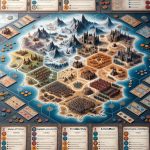Starcraft the Board Game is a beloved and highly popular game among gaming enthusiasts, known for its intense strategy and strategic depth. With its intricate dynamics and engaging gameplay, it offers a unique experience in the world of board games.
One crucial element that sets players up for success is a well-thought-out opening strategy. In this article, we will delve into the fascinating world of Starcraft the Board Game, explore its mechanics and dynamics, and uncover some successful opening strategies employed by professional players.
Starcraft the Board Game is based on the iconic video game franchise of the same name developed by Blizzard Entertainment. It allows players to take on the roles of different factions – Terran, Zerg, or Protoss – each with their own strengths and abilities. The game revolves around resource management, unit deployment, expansion, and combat. A solid understanding of these mechanics lays the foundation for formulating effective opening strategies.
Crafting an effective opening strategy is essential in Starcraft the Board Game as it sets the tone for the entire game. A well-executed opening can give players a significant advantage by providing a strong foothold on resources or launching aggressive attacks early on. On the other hand, a poorly planned opening can leave players vulnerable to opponents’ actions or slow down their progress in resource accumulation.
In this article, we will guide you through various opening strategies used by experienced players in Starcraft the Board Game. We will analyze their strengths and weaknesses while considering different playstyles and faction choices. Whether you are an experienced player looking to refine your strategy or a beginner seeking guidance, this article will provide valuable insights into honing your skills and maximizing your chances of victory in Starcraft the Board Game.
Understanding the Game Mechanics and Dynamics
Starcraft the Board Game is a dynamic and strategic game that requires players to understand and utilize its intricate mechanics in order to succeed. In this section, we will provide a brief overview of the game mechanics and how they contribute to the strategy aspect, as well as discuss the different factions and their unique abilities. Additionally, we will explore the importance of resource management in the game.
Game Mechanics
At its core, Starcraft the Board Game is a real-time strategy game that simulates intergalactic warfare. Players take on the role of one of three factions – Terran Dominion, Protoss Protectorate, or Zerg Swarm – each with their own strengths and weaknesses. The main objective is to build up a formidable army, expand your influence across various planets, and ultimately eliminate your opponents.
The game is played in rounds, with each round consisting of four phases: Production Phase, Command Phase, Battle Phase, and Income Phase. During the Production Phase, players generate resources based on controlled planets and upgrade their technology. The Command Phase allows players to issue orders to their units on planets they control. The Battle Phase determines combat outcomes between opposing units through dice rolls and ability cards. Lastly, during the Income Phase players gather additional resources for future rounds.
Factions and Unique Abilities
Each faction in Starcraft the Board Game has its own unique abilities that impact gameplay strategies. The Terran Dominion focuses on versatility and adaptability with units such as Marines, Sieg Tanks, and Battlecruisers. Their “Economic Boom” ability enables efficient resource gathering.
The Protoss Protectorate emphasizes power and advanced technology with units like Zealots, Stalkers, and Colossi. They possess powerful psychic abilities that can turn tides in battles through their “Psionic Projectiles” ability.
Finally, the Zerg Swarm excels in numbers and mutation abilities. Units like Zerglings, Roaches, and Mutalisks overwhelm opponents through sheer quantity. Their “Spawn Broodlings” ability allows them to multiply their forces rapidly.
Resource Management
Resource management is a crucial aspect of Starcraft the Board Game. Players need to strategically allocate resources to produce units, buildings, and upgrades while ensuring that they have enough income for future rounds. It’s essential to strike a balance between offensive capabilities and defensive structures.
Additionally, careful planning is required to maximize resource generation by controlling planets with high resource values or using faction-specific abilities. Building up resource-generating structures such as Refineries and Assimilators can also contribute to sustainable growth throughout the game.
Analyzing Different Opening Strategies
In Starcraft the Board Game, having a strong opening strategy is crucial for success. With various factions and unique abilities, players have the opportunity to explore different approaches to gain an advantage over their opponents. In this section, we will delve into the different opening strategies that players can employ in Starcraft the Board Game, discussing their advantages, disadvantages, and providing examples of successful strategies used by professional players.
One popular opening strategy in Starcraft the Board Game is the Rush strategy. The objective of this strategy is to quickly and aggressively attack opponents in order to gain an early advantage. To execute the Rush strategy effectively, players focus on building units that have high attack damage and speed, such as Zerglings or Zealots. By overwhelming opponents with a swift attack, players using the Rush strategy aim to disrupt their opponent’s economy and slow down their progress.
However effective the Rush strategy may be, it also comes with its drawbacks. As rushing requires significant resource investment during the early stages of the game, players using this strategy may risk falling behind in terms of long-term development if they do not successfully cripple their opponent.
Additionally, opponents who anticipate or successfully defend against a rush attack may counter with equally aggressive or defensive strategies that could leave a player vulnerable. It is important for Rush strategy players to carefully assess their opponent’s capabilities and adapt accordingly.
Another opening strategy that focuses on sustainable growth is known as the Economic Boom strategy. This approach emphasizes resource accumulation and long-term development rather than immediate aggression. Players utilizing this strategy prioritize building economic structures like Probes or Drones early on to collect resources more efficiently. It allows them to invest in higher-tier units and upgrades later in the game once they have amassed enough resources.
The Economic Boom strategy provides players with a stable foundation for future expansion and powerful late-game units. However, it requires careful resource management and defense against potential early-game attacks from aggressive opponents. Players using this strategy must strike a balance between expanding their economy and allocating resources towards defense, ensuring that they are not caught off guard by opponents who choose to rush or harass.
The Rush Strategy
In Starcraft the Board Game, players have the opportunity to employ various opening strategies to gain an advantage over their opponents. One such strategy is the “Rush” strategy, which focuses on quickly and aggressively attacking the opponent’s base in the early stages of the game. This strategy aims to disrupt the opponent’s resource gathering capabilities and cripple their economy before they have a chance to establish a strong defense.
The Rush strategy involves investing heavily in units that can deal significant damage in a short amount of time. Typically, players will prioritize training units with high attack power and mobility, such as Zerglings or Zealots. These units excel at quickly tearing down enemy structures and eliminating workers, which severely hampers the opponent’s ability to produce resources.
To execute this strategy effectively, players must be proactive and move swiftly. The element of surprise is crucial in catching opponents off guard and preventing them from adequately defending against the rush. Additionally, scouting plays a vital role in identifying any weaknesses or vulnerabilities in the opponent’s base that can be exploited during the rush.
While the Rush strategy can be devastating if executed successfully, it does carry some risks. If the initial attack fails or is repelled by the opponent’s defense, the rushing player may find themselves at a disadvantage due to their lack of economic development. It is important for players employing this strategy to have a backup plan or transition into alternative strategies if their initial rush does not yield favorable results.
In response to opponents utilizing this strategy, there are several countermeasures that can be taken. Building defensive structures like Photon Cannons or Bunkers can provide much-needed protection against enemy attacks. Investing in units that excel at defending bases, such as Siege Tanks or Spine Crawlers, also proves effective against rush strategies.
Overall, the Rush strategy offers an exciting and unpredictable approach to Starcraft the Board Game. Its quick-paced, aggressive nature provides a thrilling start to the game and can catch opponents off guard if executed correctly. However, it is important to approach this strategy with caution and adaptability, as its success relies heavily on the element of surprise and quick decision-making.
The Economic Boom Strategy
The Economic Boom Strategy in Starcraft the Board Game revolves around long-term growth and resource accumulation. This strategy focuses on establishing a strong economic foundation to support your faction’s expansion and military capabilities. By effectively managing resources, players can lay the groundwork for success in the later stages of the game.
Key Buildings, Units, and Upgrades
To execute the Economic Boom Strategy, players need to prioritize certain buildings, units, and upgrades that contribute to economic growth. The primary focus should be on constructing resource gathering structures such as refineries or assimilators, as well as expanding your base by building additional command centers or nexuses.
In terms of units, it is crucial to invest in workers early on to maximize resource collection. These workers can be used not only for collecting resources but also for building additional structures to boost production capacity. Additionally, investing in units with hi-utility value – like Siege Tanks or Reavers – allows you to defend your base while still maintaining focus on resource accumulation.
Upgrades play a vital role in enhancing the efficiency of your economy and military strength. Prioritize research into technologies that improve resource gathering rates or upgrade the offensive capabilities of essential units.
Effective Resource Management
Managing resources efficiently is key when executing the Economic Boom Strategy. It is important to strike a balance between investing resources in economic development and maintaining a capable defensive force. Allocate enough workers to gather resources effectively while ensuring you have enough units to defend against potential attacks.
To optimize resource management, periodic expansions are crucial. Establish new bases at strategic locations across the map to increase resource income and broaden control over territories. However, be prepared for potential attacks from opponents who may seek to disrupt your economic boom.
It is also beneficial to establish trade routes with allies or neutral factions, allowing you access to additional resources without diverting too many workers away from other tasks.
Tips for Success
Successfully executing the Economic Boom Strategy requires careful planning and adaptability. Here are a few tips to help you achieve sustainable growth:
- Scout your opponents: Keep an eye on other players’ expansions and military build-up. This will allow you to make informed decisions about when to prioritize economic growth or defensive measures.
- Develop a contingency plan: The Economic Boom Strategy can leave you vulnerable during the early stages of the game. Prepare a backup plan in case of unexpected attacks to minimize potential losses.
- Leverage alliances: Forge alliances with other players to ensure protection while focusing on economic expansion. Trade resources or establish joint defenses to strengthen your position.
- Prioritize upgrades: Improving the efficiency of resource gathering structures, units, and technologies is essential for sustaining long-term economic growth.
By implementing these strategies and adapting them based on your faction’s unique abilities and opposing players’ actions, you can successfully execute the Economic Boom Strategy in Starcraft the Board Game and dominate the battlefield through superior resources and a strong economy.
Assessing the Risk-Reward Factor
In Starcraft the Board Game, one of the key elements that players need to consider when developing their opening strategy is the risk-reward factor. This factor involves analyzing the potential risks and rewards associated with different strategic choices and determining which approach will be most advantageous.
One aspect of assessing the risk-reward factor is considering the potential risks that may arise from specific opening strategies. For example, employing a rush strategy focuses on quick and aggressive attacks to overwhelm opponents early in the game. While this can be highly effective if executed successfully, there is also a risk involved.
If an opponent manages to defend against the rush and counterattack effectively, it could leave the rushing player at a significant disadvantage later in the game. On the other hand, an economic boom strategy emphasizes sustainable growth and resource accumulation. This strategy carries a different set of risks, such as potentially slower initial progress compared to more aggressive approaches.
To mitigate these risks, players must carefully analyze their opponents’ moves and make adaptations accordingly. Scouting plays a crucial role in gathering information about opponents’ strategies early on. By studying their factions’ abilities, unit compositions, and resource management tactics, players can adjust their own strategies to counteract or exploit these observations.
However, it’s important for players to remember that assessing risk doesn’t just involve evaluating potential pitfalls; it also entails identifying potential rewards. Each opening strategy has its own benefits that can influence gameplay outcomes positively.
For instance, executing a successful rush strategy may provide a significant advantage by disrupting opponents’ plans early on and putting them on the defensive. On the other hand, an economic boom approach allows for long-term growth and increased resource accumulation, providing players with stronger foundations for future expansion and warfare.
To create strategic depth within Starcraft the Board Game, it’s essential for players to assess risk versus reward when crafting their opening strategies. While there are inherent risks tied to each strategy, it’s up to the players to understand these risks, make calculated decisions, and adapt to changing circumstances. By doing so, players can optimize their strategies and increase their chances of achieving victory in this highly competitive board game.
Creating Your Own Opening Strategy
When it comes to Starcraft the Board Game, one of the most exciting aspects is creating your own opening strategy. While there are established strategies that players can follow, developing a customized plan based on your playstyle and faction choice can give you a unique advantage on the board. In this section, we will explore the process of creating your own opening strategy and provide some examples of successful player-created strategies.
To begin creating your opening strategy, it’s important to assess your strengths and weaknesses as a player. Are you more inclined towards aggressive gameplay or do you prefer a more defensive approach? Understanding your playstyle will help you determine which type of strategy will be best suited for you. Additionally, knowing the faction you are playing and their unique abilities is crucial in creating an effective opening strategy.
Next, consider the objectives you want to achieve with your strategy. Do you want to focus on early game domination through quick expansion and unit production? Or do you prefer a more long-term growth approach that focuses on resource accumulation and tech advancement? By setting clear objectives, you can then identify key buildings, units, upgrades, and tactics that align with those goals.
Once you have formulated your initial strategy, it’s important to experiment and adjust as needed. Playtest your strategy against different opponents and factions to gauge its effectiveness. Keep track of what works well and what doesn’t, making adjustments accordingly. Don’t be afraid to iterate or even scrap certain aspects of your strategy if they are not yielding desired results.
Successful player-created opening strategies often take into account factors such as opponent scouting, adaptability, and surprise elements. By considering these elements in your own strategy creation process, you can stay one step ahead of your opponents and increase your chances of success on the board.
| Aspect | Description |
|---|---|
| Strengths and Weaknesses | Assess your playstyle and identify key strengths and weaknesses as a player. |
| Faction Abilities | Know the unique abilities of the faction you are playing and leverage them in your strategy. |
| Objectives | Determine specific goals for your strategy such as early game domination or long-term growth. |
Practice and Refine
Once you have chosen an opening strategy in Starcraft the Board Game, it is essential to practice and refine it to maximize its effectiveness. By dedicating time and effort into mastering your chosen strategy, you can gain a significant advantage over your opponents and increase your chances of success.
To begin perfecting your opening strategy, it is crucial to familiarize yourself with the intricacies of the chosen approach. Make sure you understand the timing, unit compositions, and overall objectives involved in executing the strategy. This understanding will allow you to make informed decisions during gameplay and adapt accordingly.
One effective way to practice your opening strategy is by engaging in solo play or playing against AI opponents. Solo play allows you to focus solely on honing your strategy without external variables or opponents making unexpected moves. Take note of areas where you may encounter difficulties or face challenges during this practice phase.
Once you feel confident with solo play, consider playing against other human opponents who are also well-versed in Starcraft the Board Game. This will expose you to diverse strategies, tactics, and playstyles that can help improve your game awareness and decision-making abilities.
Throughout this practice phase, constantly evaluate and analyze your performance. Pay attention to both successful maneuvers and any weaknesses or flaws in your execution. Identify areas for improvement and actively seek ways to address them. This self-reflection will aid in refining your opening strategy and ensuring it remains effective in different scenarios.
As you continue practicing, keep track of any adjustments or adaptations required based on each opponent’s unique actions during gameplay. The ability to adapt on-the-fly is essential as no two games will unfold exactly the same way. Make necessary tweaks or modifications to your strategy as needed while staying true to its core principles.
Lastly, never underestimate the value of learning from experience. Even if a particular game does not go according to plan, use it as an opportunity for growth. Analyze your mistakes, assess what went wrong, and brainstorm ways to rectify them in future games. Remember, practice makes perfect, and refining your opening strategy is an ongoing process that requires continuous effort.
By practicing and refining your opening strategy, you can elevate your gameplay and increase your chances of success in Starcraft the Board Game. Remain dedicated, open to learning from others, and embrace opportunities for improvement. With time and persistence, you will be well on your way to mastering your chosen strategy and enjoying the strategic depth of the game.
| Practice Tips | Refinement Techniques |
|---|---|
| Engage in solo play or play against AI opponents to focus on honing your strategy without external variables. | Evaluate performance regularly, identify areas for improvement, and actively seek ways to address them. |
| Play against human opponents who are also well-versed in the game to expose yourself to diverse strategies and playstyles. | Adapt on-the-fly based on opponent actions while staying true to core strategy principles. |
| Constantly evaluate both successful maneuvers and weaknesses/flaws in execution. | Learn from experience by analyzing mistakes, identifying what went wrong, and brainstorming solutions for future games. |
Conclusion
In conclusion, Starcraft the Board Game offers a dynamic and strategic gaming experience that has captured the attention of gaming enthusiasts worldwide. With its unique game mechanics and diverse factions, having a solid opening strategy is essential for success in this game.
Throughout this article, we have explored various opening strategies in Starcraft the Board Game. From the quick and aggressive Rush strategy to the sustainable growth of the Economic Boom strategy, players have a range of options to choose from. By understanding the advantages and disadvantages of each strategy, players can make informed decisions on which approach suits their playstyle and faction choice.
It is important to emphasize that creating your own opening strategy is not only possible but also encouraged in Starcraft the Board Game. By tailoring your strategy to your personal strengths and weaknesses, you can gain a competitive edge over your opponents. The key lies in practice and refinement – learning from your experiences, adjusting as needed, and continually honing your skills.
Frequently Asked Questions
What is the strategy of StarCraft 2?
The strategy of StarCraft 2 is a combination of micro-management, macro-management, and overall decision-making skills. Micro-management refers to controlling individual units effectively in battles by giving them specific commands to attack or retreat. Macro-management involves efficiently managing resources, expanding one’s base, and producing units on a large scale to maintain an advantage over the opponent.
Overall decision-making encompasses strategic choices such as scouting the enemy’s base, adapting the army composition based on the opponent’s race and tactics, and choosing appropriate timings for attacking or defending. By successfully balancing these aspects and adapting to different game situations, players aim to outsmart their opponents and ultimately win the game.
How do I get better at StarCraft 2?
Improving at StarCraft 2 requires dedicated practice, study, and experience. One essential component is consistently playing the game to develop muscle memory and reflexes in order to execute actions more efficiently. Moreover, watching replays or professional matches can provide valuable insights into different strategies and techniques employed by skilled players.
Analyzing these replays helps players understand what works and what doesn’t in specific situations. Additionally, studying build orders (specific sequences of unit production) can be beneficial for improving resource management and overall strategic planning during gameplay. Lastly, seeking guidance from experienced players or joining communities that offer coaching can accelerate learning by receiving personalized feedback regarding strengths and weaknesses.
Is there a StarCraft board game?
Yes, there is a StarCraft board game called “StarCraft: The Board Game.” It was published by Fantasy Flight Games in 2007 as a strategic board game adaptation of the popular video game franchise. In this board game version, players take control of one of the three races (Terran, Protoss or Zerg) as they compete for dominance over planets in space battles.
The objective is to gather resources efficiently while building armies to conquer your opponents’ bases through tactical maneuvers on a hexagonal map. The board game introduces new mechanics but captures many elements found in the video game, allowing fans of StarCraft to experience the strategic warfare of the franchise in a different format.

I love playing all kinds of games – from classics like Monopoly to modern favourites like Ticket to Ride.
I created this blog as a way to share my love of board games with others, and provide information on the latest releases and news in the industry.





